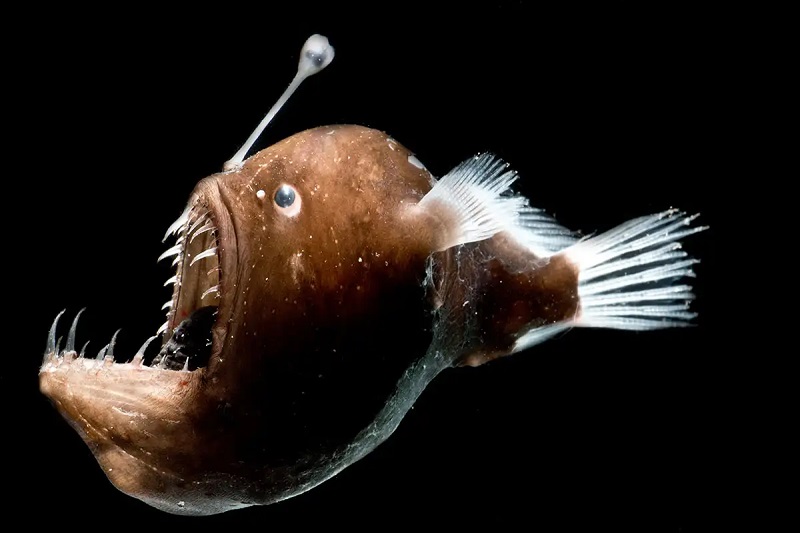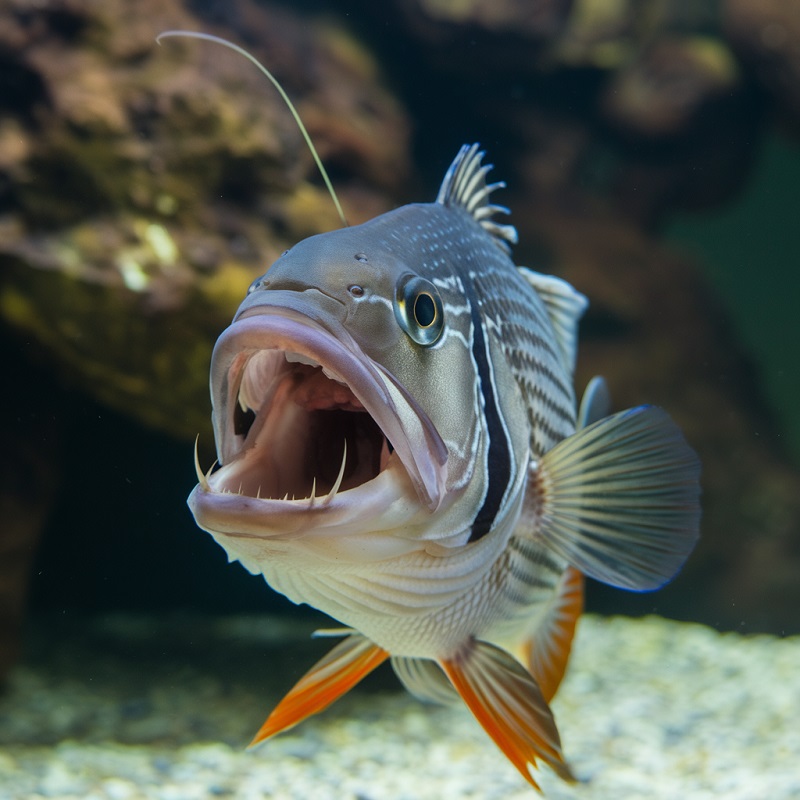Angler fish are some of the most fascinating creatures of the deep ocean, often depicted with eerie, glowing lures in science fiction. But one common question remains: Are angler fish found in cold waters?
The answer is a resounding yes! Many species of angler fish thrive in the dark, frigid depths of the ocean, particularly in deep-sea trenches and Arctic waters. Their ability to survive in such extreme conditions is due to specialized adaptations like bioluminescence, antifreeze proteins, and slow metabolisms.
In this article, we’ll explore the cold-water habitats of angler fish, their evolutionary adaptations, and how they manage to hunt and reproduce in these icy depths.
What Are Angler Fish?
Angler fish belong to the order Lophiiformes, known for their bioluminescent lures used to attract prey in the darkness of the deep sea. They are ambush predators, waiting patiently for unsuspecting fish to approach before snapping them up with their large, sharp-toothed mouths.
Key Characteristics of Angler Fish:
- Bioluminescent lure – Used to attract prey in total darkness.
- Large mouth & expandable stomach – Allows them to swallow prey larger than themselves.
- Slow metabolism – Helps them conserve energy in nutrient-scarce environments.
- Diverse species – Found in both cold and warm ocean regions.
Where Do Angler Fish Live?
Angler fish are found worldwide, but their preferred habitats vary by species. Many thrive in cold, deep-sea environments, while others adapt to shallower, warmer waters.
Cold Water Habitats of Angler Fish
| Habitat | Depth | Temperature |
| Deep Ocean Trenches | 1,000m – 4,000m+ | 0-4°C (32-39°F) |
| Arctic & Antarctic Waters | 200m – 1,500m | -2 to 4°C (28-39°F) |
| Temperate Deep Waters | 200m – 1,000m | 4-10°C (39-50°F) |
Deep Ocean Trenches
- Found in the Mariana Trench and other abyssal zones.
- Complete darkness and extreme cold conditions.
- Angler fish use bioluminescence to lure prey in total blackness.
- Scientific Data: Studies by NOAA’s deep-sea expeditions indicate that angler fish are frequently observed at depths greater than 2,000 meters in the Pacific and Atlantic Oceans.
Arctic & Antarctic Waters
- Species like Lasiognathidae live in near-freezing waters.
- Special enzymes and antifreeze proteins prevent their blood from freezing.
- Expedition Reference: The 2018 Arctic Deep-Sea Expedition recorded angler fish species below 1,000m in the Arctic Circle, showcasing their adaptation to extreme cold.
Temperate Deep Waters
- Some angler fish live in cold, nutrient-rich waters off the coasts of North America and Europe.
- Less extreme than deep trenches but still cold enough for specialized adaptations.

Dante Fenolio/Science Photo Library
Why Are Angler Fish Best Suited for Cold Waters?
So, why are cold waters such a great habitat for angler fish?
Adaptations to Cold Environments
Angler fish are specially equipped to survive in these frigid waters. For one, they have a slower metabolism, which is an advantage in the cold, where energy conservation is key. They don’t need to chase prey at high speeds because of the low availability of food, and they can go long periods without eating.
Additionally, angler fish are equipped with unique enzymes and antifreeze proteins that help them survive in temperatures that would be lethal to many other fish.
Food Availability in Cold Waters
Cold waters, particularly in deep ocean currents, provide a consistent supply of food for angler fish. While the temperature is low, the depth ensures that there’s a steady flow of organic material, from small plankton to larger fish that live in these dark depths. The angler fish’s lure helps attract this food, even in the total darkness of the deep sea.
Low Competition in Deep Waters
The cold depths of the ocean are a relatively empty space compared to shallow waters. With fewer predators and competitors, angler fish are at the top of the food chain in their niche, making it an ideal environment to thrive and reproduce.
The Role of Temperature in Angler Fish Behavior
Temperature plays a significant role in the behavior and lifestyle of angler fish.
Hunting Behavior
In the frigid depths of cold waters, angler fish don’t need to expend much energy hunting. Their hunting strategy revolves around patience and precision. They use their glowing lure to attract prey, and once an unsuspecting fish or invertebrate gets close enough, they snap it up in their large mouths.
Reproductive Cycles in Cold Waters
Temperature also impacts the reproductive cycles of angler fish. Many deep-sea species spawn during specific seasons when food is more abundant, and conditions are just right. Because cold waters tend to be more stable, angler fish can find relatively predictable conditions for raising their young.
Bioluminescence in Cold Waters
One of the most interesting aspects of angler fish is their bioluminescence. This glowing lure is essential for survival in the dark, cold waters where visibility is nearly nonexistent. The light attracts prey that might otherwise never come close to a predator, making it a highly effective tool for feeding in these depths.
Common Species of Angler Fish Found in Cold Waters
Several species of angler fish are adapted to cold, deep-water habitats.
Himantolophidae Family
One of the most well-known families of deep-sea angler fish is the Himantolophidae family. These species live at extreme depths, often in waters colder than 4°C (39°F). Their large, bioluminescent lures and terrifying appearance make them fascinating subjects of study for marine biologists.
Lasiognathidae Family
Another family of angler fish that thrives in cold waters is the Lasiognathidae family. These species are often found in the Arctic and Antarctic regions, where temperatures drop to near freezing. These fish have evolved to survive in some of the harshest conditions on Earth.
Other Notable Species in Polar Waters
While many angler fish species are deep-sea dwellers, some species inhabit colder, temperate waters closer to the surface. These species are generally smaller and less intimidating but still exhibit the classic bioluminescent lure.
Are There Angler Fish in Warm Waters?
While many angler fish thrive in cold waters, they are also found in warm waters, especially around the equator. These warmer waters are home to different species of angler fish that have adapted to the warmer, nutrient-rich environment.
Some angler fish, like the ones found in warm water, are smaller and may not have the same deep-sea adaptations as their cold-water relatives. The variety of species shows how versatile the angler fish is in adapting to various ocean environments.
How Can Angler Fish Adapt to Cold Waters?
Angler fish have developed several unique adaptations to survive in cold waters.
Physiological Adaptations
The primary adaptation is the ability to survive in low temperatures. Many angler fish have evolved antifreeze proteins that prevent their bodies from freezing in sub-zero temperatures. These proteins help them maintain fluidity in their blood, allowing them to thrive in the coldest parts of the ocean.
Behavioral Adaptations
Behaviorally, angler fish are incredibly energy-efficient. They don’t need to move fast or hunt frequently, as food is generally more abundant in cold, deep-sea environments. This slow-paced lifestyle helps them conserve energy while still attracting prey with their glowing lures.
Read More about Arctic Char vs Salmon
Common Cold-Water Angler Fish Species
Several species of angler fish have evolved to thrive in frigid waters:
| Species | Habitat | Special Adaptation |
| Himantolophidae | Deep-sea trenches | Large lure, slow metabolism |
| Lasiognathidae | Arctic & Antarctic | Antifreeze proteins |
| Melanocetidae (Black Seadevil) | 1,500m+ depth | Extreme bioluminescence |
| Cryptopsaras couesii | Deep Atlantic | Adapted for extreme pressure and cold |
Conclusion: Are Angler Fish Found in Cold Waters?
Absolutely! Many angler fish species are perfectly suited to cold-water habitats, particularly in deep-sea trenches and Arctic waters. Their bioluminescent lure, slow metabolism, and antifreeze proteins make them well-equipped for life in some of the harshest conditions on Earth.
Scientific Insight: Recent studies in Nature Communications suggest that angler fish in deep-sea environments have evolved genetic mutations that enhance their cold tolerance, making them one of the most extreme deep-sea survivors.
These mysterious creatures continue to amaze marine biologists with their extreme survival skills, proving that life finds a way even in the most inhospitable environments.
Faqs
What depth do angler fish typically live at?
Angler fish are typically found at depths ranging from 200 meters to over 2,000 meters (650 to 6,500 feet) below sea level, where temperatures are near freezing.
How do angler fish survive in the dark, cold ocean?
Angler fish have evolved bioluminescent lures to attract prey in the darkness. They also have antifreeze proteins in their bodies to prevent freezing and slow metabolisms that help them survive in cold conditions.
Can angler fish be found in the Arctic?
Yes, some species of angler fish inhabit the cold waters near the Arctic, particularly in deep-sea regions.
Why is bioluminescence important for angler fish in cold waters?
Bioluminescence helps angler fish attract prey in the pitch-black depths of cold waters, where there is little to no natural light.




